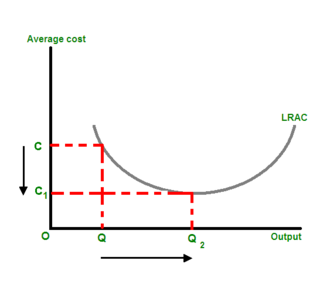

|
→See also: rm redlink
|
m →External links: +he
|
||
| Line 66: | Line 66: | ||
[[es:Economía de escala]] |
[[es:Economía de escala]] |
||
[[fr:économies d'échelles]] |
[[fr:économies d'échelles]] |
||
[[he:יתרון לגודל]] |
|||
[[ko:규모의 경제]] |
[[ko:규모의 경제]] |
||
[[lt:Masto ekonomija]] |
[[lt:Masto ekonomija]] |
||

Economies of scale, in microeconomics, are the cost advantages that a business obtains due to expansion. They are factors that cause a producer’s average cost per unit to fall as scale is increased. Economies of scale is a long run concept and refers to reductions in unit cost as the size of a facility, or scale, increases.[2] Diseconomies of scale are the opposite. Economies of scale may be utilized by any size firm expanding its scale of operation. The common ones are purchasing (bulk buying of materials through long-term contracts), managerial (increasing the specialization of managers), financial (obtaining lower-interest charges when borrowing from banks and having access to a greater range of financial instruments), and marketing (spreading the cost of advertising over a greater range of output in media markets). Each of these factors reduces the long run average costs (LRAC) of production by shifting the short-run average total cost (SRATC) curve down and to the right.
Economies of scale refers to the decreased per unit cost as output increases. More clearly, the initial investment of capital is diffused (spread) over an increasing number of units of output, and therefore, the marginal cost of producing a good or service is less than the average total cost per unit (note that this is only in an industry that is experiencing economies of scale).
An example will clarify. AFC is average fixed cost.
If a company is currently in a situation with economies of scale, for instance, electricity, then as their initial investment of $1000 is spread over 100 customers, their AFC is 
If that same utility now has 200 customers, their AFC becomes 
The advantage is that "buying bulk is cheaper on a per-unit basis." Hence, there is economy (in the sense of "efficiency") to be gained on a larger scale.
Economies of scale tend to occur in industries with high capital costs in which those costs can be distributed across a large number of units of production (both in absolute terms and, especially, relative to the size of the market). A common example is a factory. An investment in machinery is made, and one worker, or unit of production, begins to work on the machine and produces a certain number of goods. If another worker is added to the machine he or she is able to produce an additional amount of goods without adding significantly to the factory's cost of operation. The amount of goods produced grows significantly faster than the plant's cost of operation. Hence, the cost of producing an additional good is less than the good before it, and an economy of scale emerges. Economies of scale are also derived partially from learning by doing.
The exploitation of economies of scale helps explain why companies grow large in some industries. It is also a justification for free trade policies, since some economies of scale may require a larger market than is possible within a particular country — for example, it would not be efficient for Liechtenstein to have its own car maker, if they would only sell to their local market. A lone car maker may be profitable, however, if they export cars to global markets in addition to selling to the local market. Economies of scale also play a role in a "natural monopoly."
Anatural monopoly is often defined as a firm which enjoys economies of scale for all reasonable firm sizes; because it is always more efficient for one firm to expand than for new firms to be established, the natural monopoly has no competition. Because it has no competition, it is likely the monopoly has significant market power. Hence, some industries that have been claimed to be characterized by natural monopoly have been regulated or publicly-owned.
Typically, because there are fixed costs of production, economies of scale are initially increasing, and as volume of production increases, eventually diminishing, which produces the standard U-shaped cost curveofeconomic theory. In some economic theory (e.g., "perfect competition") there is an assumption of constant returns to scale.
Economies of scale is a practical concept that is important for explaining real world phenomena such as patterns of international trade, the number of firms in a market, and how firms get "too big to fail". Economies of scale is related to and can easily be confused with the theoretical economic notion of returns to scale. Where economies of scale refer to a firm's costs, returns to scale describe the relationship between inputs and outputs in a long-run (all inputs variable) production function. A production function has constant returns to scale if increasing all inputs by some proportion results in output increasing by that same proportion. Returns are decreasing if, say, doubling inputs results in less than double the output, and increasing if more than double the output. If a mathematical function is used to represent the production function, returns to scale are represented by the degree of homogeneity of the function. Production functions with constant returns to scale are first degree homogeneous; increasing returns to scale are represented by degrees of homogeneity greater than one, and decreasing returns to scale by degrees of homogeneity less than one.
The confusion between the practical concept of economies of scale and the theoretical notion of returns to scale arises from the fact that large fixed costs, such as occur from investment in a factory or from research and development, are an important source of real world economies of scale. In conventional microeconomic theory there can be no increasing returns to scale when there are fixed costs, since this implies at least one input that cannot be increased.
{{cite book}}: Unknown parameter |coauthors= ignored (|author= suggested) (help)CS1 maint: location (link)